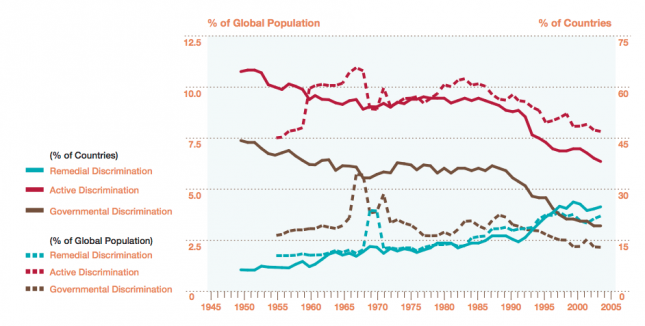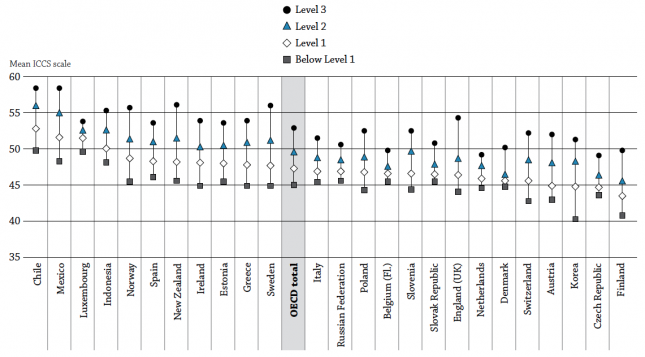Notice: This is only a preliminary collection of relevant material
The data and research currently presented here is a preliminary collection or relevant material. We will further develop our work on this topic in the future (to cover it in the same detail as for example our entry on World Population Growth).
If you have expertise in this area and would like to contribute, apply here to join us as a researcher.
Human rights describe moral norms or moral standards which are understood as inalienable fundamental rights of every human person. Human rights encompass a wide variety of rights, including but not limited to the right to a fair trial, protection of physical integrity, protection against enslavement, the right to free speech, and the right to education.
The protection of human rights is certainly one of the most important aspects of development. Nevertheless, it receives much less attention than other aspects, presumably in part because it is so very hard to measure. If one is interested in empirically studying the protection of human rights, it is not enough to count countries that ratify human rights treaties; instead, the quantitative study of human rights aims to determine whether or not certain human rights are protected in practice.
All our charts on Human Rights
The problem: the standards by which we assess human rights violations increase over time, which poses a problem for measurement.
One of the fundamental drivers in the safeguarding of human rights is the recognition of new dimensions along which individual rights can be violated. From an ethical perspective, therefore, it is necessary to raise the standards of human rights if your aim is to abolish more and more oppressive practices by which individuals’ human rights can be abused.
From an empirical perspective, however, raising the standards by which we evaluate whether or not human rights are protected is problematic, because it becomes increasingly difficult to compare human rights violations over time: what constitutes an egregious violation today might have been considered common practice two-hundred years ago.
The solution: correct for changing standards of accountability.
In a landmark paper – Fariss (2014)1 – the political scientist Christopher J. Fariss investigated whether the standards by which human rights organisations measure the protection of human rights have indeed changed over time.
Fariss’ assessment of the protection of human rights focussed on the protection of the physical integrity of citizens. He aimed to measure how a government protects its citizens’ physical integrity, by taking into account torture, government killing, political imprisonment, extrajudicial executions, mass killings and disappearances.
To correct for the bias introduced by changing standards in the measurement of human rights protection, Fariss developed the ‘dynamic standard model’. In this model, he adjusted for the bias in measurements so that the protection of human rights can be compared over time. Fariss used the available data on human rights violations, then employed statistical techniques to correct for changing standards.
His empirical measurements of human right protection are presented in the visualisation here. You can move the slider underneath the map to see the change over time, and by switching to the Chart view you can see his assessment of human rights protection country-by-country over time.
How to read this chart: Higher values – higher human rights scores – indicate better human rights protection.
The human rights scores represent the relative position of one country in one specific year relative to the average of all countries across the entire period (1949-2014), which is set to zero. The human rights scores represent standard deviations above and below zero: as illustrated, the worst and best country-years fall 2 to 3 standard deviations below or above the baseline.
The finding of the research: After correcting for the shifting standards of human right measurements, Fariss concluded that globally, ‘physical integrity practices have improved over time.’
This finding is unequivocally positive, but is made all the more salient in the context of unadjusted data from human right organizations, which indicate that there has been no trend of either improving or worsening human rights protection. Fariss concluded that ‘the pattern of constant abuse found in data derived from human rights reports is not an indication of stagnating human rights practices. Instead, it reflects a systematic change in the way monitoring agencies, like Amnesty International and the U.S. State Department, encounter and interpret information about human rights abuses.’
Fariss’ research findings suggest that the reason we saw no trend in human rights protection is that as it improved, so did the standards by which we measure it.
Viewed in the Chart view this visualization shows the human rights protection scores for each country over time.
Economic Freedom
Press Freedom
This map shows the share of women who have gone through partial or total removal of the female external genitalia or other injury to the female genital organs for cultural or other non-therapeutic reasons. Data is only available for African and Middle Eastern countries.
Lethal violence against minorities
There is little long-term data on the treatment of minorities. Records however do exist for the most extreme forms of violence such as lynchings. Lynching are extrajudicial public executions by self-appointed commissions, mobs, or vigilantes.
The Tuskegee Institute – which is now Tuskegee University – recorded data on lynchings in the USA. Their data is shown here.2
Lynchings in the United States, 1882-19693
Download Data‘Do you approve or disapprove of marriage between blacks and whites?’ Share approving black-white marriage among whites and blacks in the USA, 1958-2013 – Gallup (2013)4
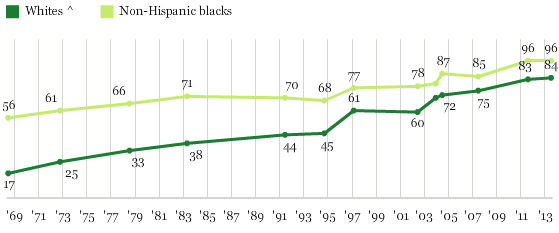
Opposition to laws in the USA banning marriages between blacks and whites by year and year of birth, 1964-2000 – Fischer and Hout (2008)5
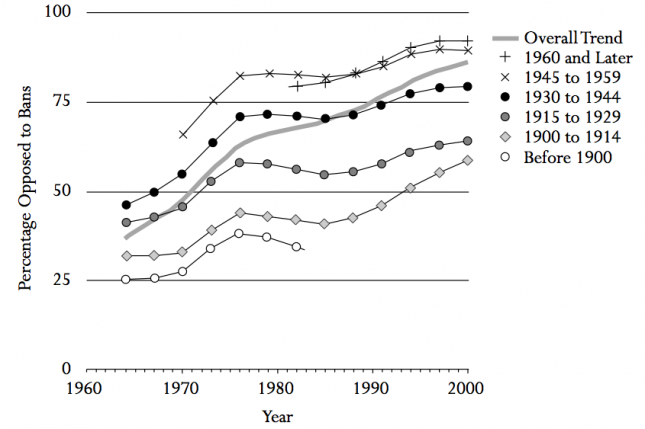
Racism outside the USA
The chart shown plots the level of GDP per capita against the Human Rights Protection Score from Schnakenberg and Fariss. We see that more prosperous countries tend to protect human rights better. Some resource rich economies – Saudi-Arabia, Kuwait, Equatorial-Guinea and others – are outliers which are both rich and have low human rights protection scores. The countries with the lowest human rights protection scores are also poor economies.
Use of the phrases ‘civil rights’, ‘women’s rights’, ‘children’s rights’, ‘gay rights’ and ‘animal rights’ in English-language books, 1900-2008 – Google Ngram8

Shifting social views on homosexuality, women and race in the USA (in %), 1987-2012 – Pew Research9
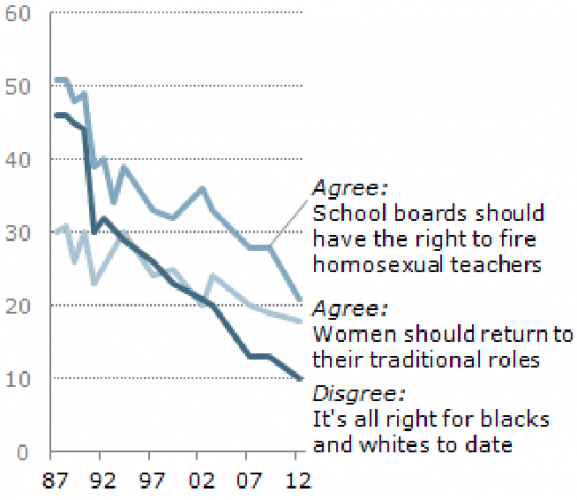
Social values correlation: gender equality scale and approval of homosexuality for select countries, 1995-2001 – Norris and Inglehart (2004)10
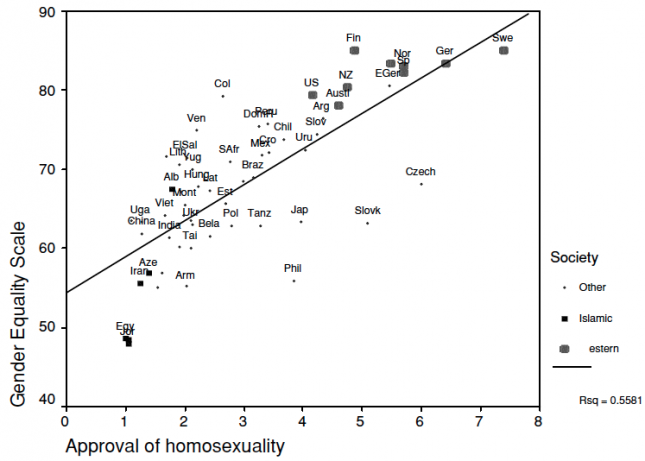
- Data: Survey answers to questions about various social values
- Geographical coverage: Almost 100 countries
- Time span: 1981 to present
- Available at: Online here
- Data: Survey answers to questions about various social values
- Geographical coverage: 47 European countries and regions
- Time span: 1981-2008
- Available at: Online here
- Data: This assessment of the protection of human rights focusses on the protection of the physical integrity of citizens. He aims to measure how a government protects the physical integrity takes into account torture, government killing, political imprisonment, extrajudicial executions, mass killings and disappearances.
- Geographical coverage: Global by country
- Time span: 1949 to 2014
- Available at: www.humanrightsscores.org
- produced by Christopher Farris and Keith Schnakenberg.
Published in: Christopher J. Fariss. 2014. Respect for Human Rights has Improved Over Time: Modeling the Changing Standard of Accountability. American Political Science Review 108(2):297-318 (May 2014).– Supplementary Materials: Keith Schnakenberg and Christopher J. Fariss. 2014. Dynamic Patterns of Human Rights Practices. Political Science Research and Methods 2(1):1-31 (April 2014).
The Minorities at Risk project tracks 283 politically active ethnic groups throughout the world from 1945 to the present. The website is here.
